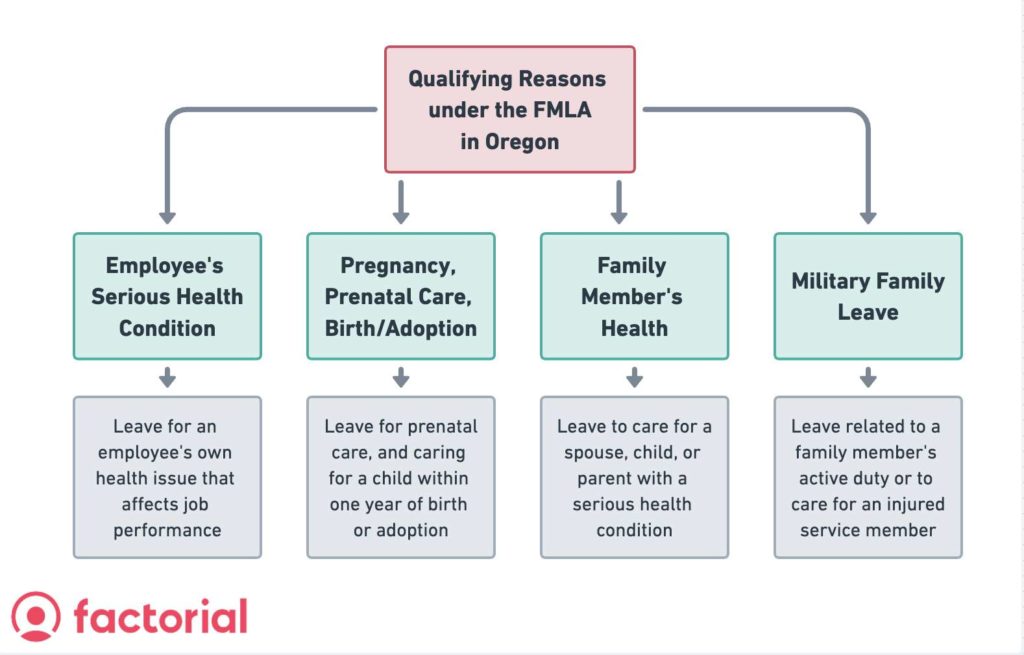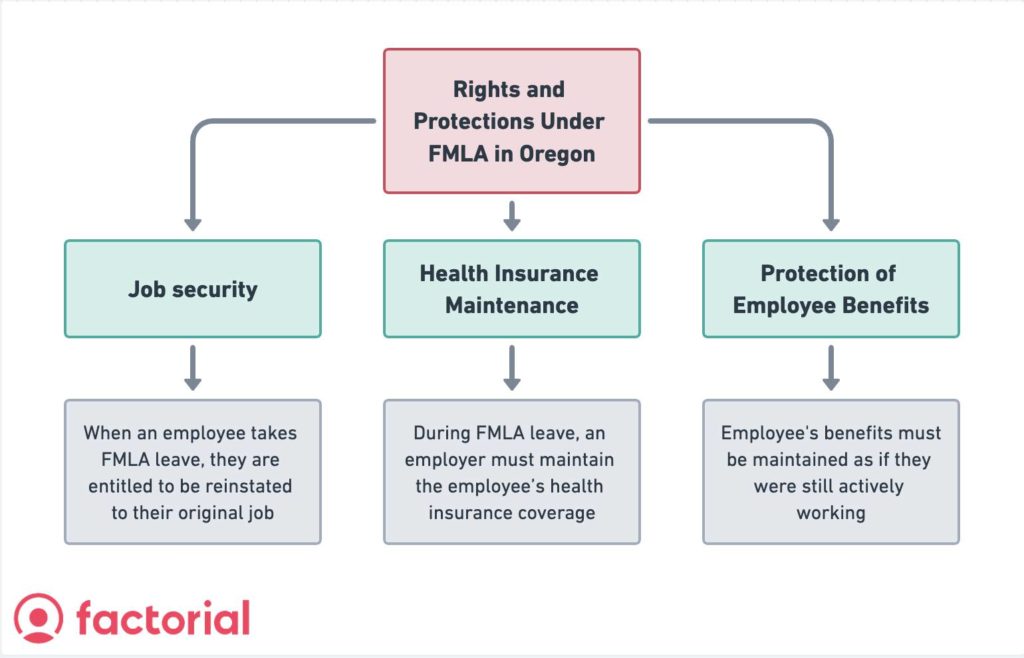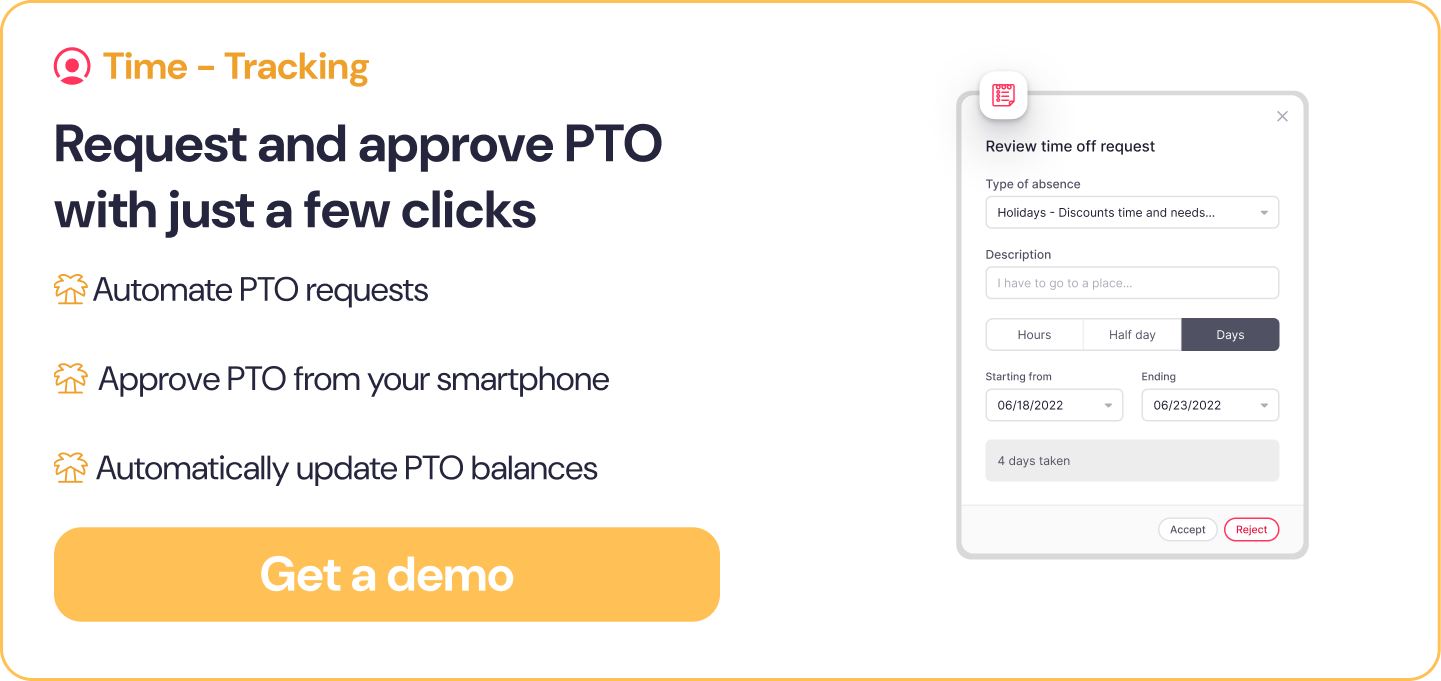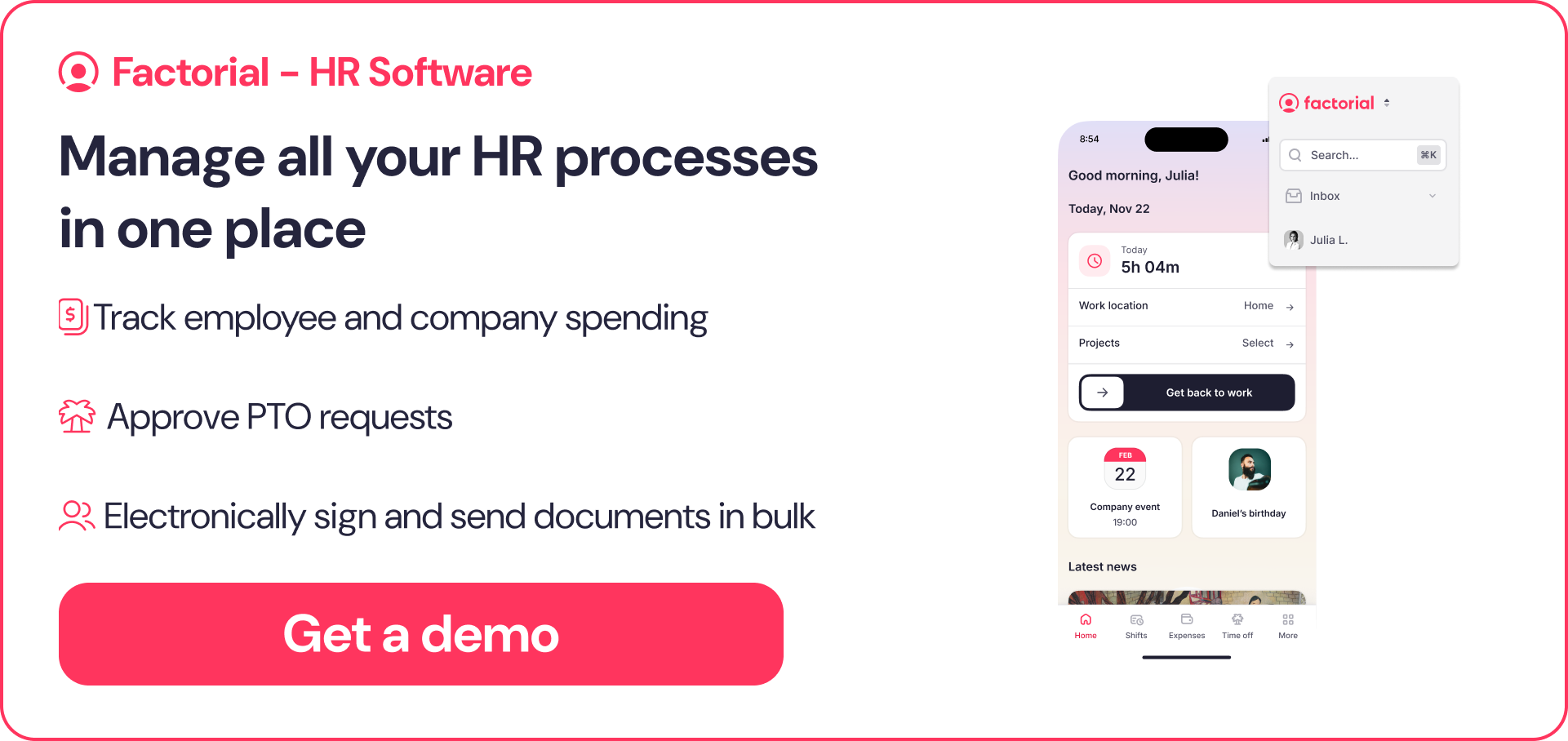The Family and Medical Leave Act (FMLA) is a pivotal federal law that offers critical protections to employees needing to take time off for specific family or medical reasons. In Oregon, this law is augmented by state-specific legislation, such as the Oregon Family Leave Act (OFLA) and Paid Leave Oregon, providing additional layers of support and coverage to Oregon’s workforce.
Let’s understand how FMLA and OFLA work in more detail.
TABLE OF CONTENTS
- What is Family and Medical Leave Act (FMLA) Oregon?
- FMLA: Eligibility Criteria in Oregon
- Qualifying Reasons under the FMLA in Oregon
- Duration and Types of Family and Medical Leaves in Oregon
- Employee Rights and Employer Obligations Under the FMLA Leave
- How To Request FMLA Leave in Oregon
- Federal vs State Specifics: Comparison of FMLA and Oregon State’s OFLA
- Resources about FMLA in Oregon
- FAQ About Family And Medical Leave in Oregon
- Effortlessly Track Employee Time Off With This HR Software ✅
What is Family and Medical Leave Act (FMLA)?
The Family and Medical Leave Act (FMLA), passed in 1993, has upheld workers’ rights during times of crisis. Specifically, it protects employees facing health challenges by preventing them from losing their jobs and providing them with a leave of absence to focus on recovery.
In essence, FMLA allows employees 12 weeks of unpaid, job-protected leave per year while maintaining their health insurance coverage. All government agencies, elementary and secondary schools, and companies with 50 or more employees are covered by this law. FMLA covers a wide range of situations, including illness, childbirth, adoption, and military family circumstances.
FMLA: Eligibility Criteria in Oregon
In Oregon, the Family and Medical Leave Act (FMLA) sets specific criteria to determine who is covered under its provisions.

- Employer Eligibility: FMLA applies to private-sector employers with 50 or more employees within a 75-mile radius, for at least 20 workweeks in the current or preceding calendar year. It also encompasses all public agencies, including local, state, and federal employers, and public and private elementary and secondary schools, regardless of the number of employees.
- Employee Eligibility: To be eligible for FMLA leave, an employee must have worked for a covered employer for at least 12 months (not necessarily consecutive). They must have worked a minimum of 1,250 hours during the 12 months prior to the start of the FMLA leave. The employee should be working at a location where the employer has at least 50 employees within a 75-mile radius.
Qualifying Reasons under the FMLA in Oregon
Under the Family and Medical Leave Act (FMLA) in Oregon, employees are entitled to take leave for several significant reasons:

- Personal: Leave for an employee’s own serious health issue
- Family Member’s Serious Health Conditions: This includes to care for a spouse, child, or parent suffering from a serious health condition.
- Birth, Adoption, or Foster Care Placement of a Child: FMLA allows parents to take leave for the birth of a child, as well as for the adoption or foster care placement of a child, providing time for bonding and care.
- Military-Related Exigencies and Caregiver Leave: Employees may take leave for reasons related to a family member’s military service, including exigencies arising from a family member’s deployment. FMLA also provides for a longer leave (up to 26 weeks) to care for a family member who is a service member with a serious injury or illness.
Duration and Types of Family and Medical Leaves in Oregon
Duration of leaves under the Family and Medical Leave Act (FMLA)
- Maximum Duration of FMLA Leave: Employees are entitled to a maximum of 12 weeks of unpaid leave within a 12-month period. In the case of military caregiver leave, this duration extends to 26 weeks.
Types of Family and Medical Leaves in Oregon
- Continuous Leave: This involves taking a continuous, uninterrupted leave period.
- Intermittent Leave: This type of leave allows employees to take FMLA leave in separate blocks of time due to a single qualifying reason.
- Reduced Schedule Leave: This allows an employee to reduce their working hours, either daily or weekly, for a period of time due to a qualifying reason.
Employee Rights and Employer Obligations Under the FMLA Leave

Under the FMLA, employers are required to comply with specific regulations concerning their employees’ job status.
- Job Security: Employees are guaranteed the right to return to the same or an equivalent position.
- Health Insurance Maintenance: Employers must maintain the employee’s health insurance under the same terms and conditions as if they had not taken leave. In the case that employees opted for premiums, they are responsible for their portion of their health insurance premiums.
- Protection of Employee Benefits: Employee’s benefits are maintained as if the worker is actively working.
- Employer’s Role in Granting Leave and Maintaining Compliance: Employers are required to grant leave to eligible employees for qualifying reasons under the FMLA. They must also keep accurate records and comply with all aspects of the FMLA, including not interfering with, restraining, or denying the exercise of FMLA rights. In addition, employers are prohibited from retaliating against employees for taking FMLA leave.
How To Request FMLA Leave in Oregon
Step-by-Step Guide on How Employees Can Request FMLA Leave
- Determine Eligibility: You must work at a location with 50 or more employees within a 75-mile radius and be employed for at least 12 months by a covered employer.
- Understand the Reason for Leave: Determine your FMLA qualifying reason, such as personal health issues, family member care, birth or adoption of a child, or military exigencies.
- Notify Your Employer: Notify your employer in writing or verbally of your need for FMLA leave. While immediate notice is not always possible, FMLA generally requires 30 days’ advance notice.
- Submit Required Forms and Documentation: Complete any FMLA leave request forms provided by your employer. Provide medical certification or other required documentation to support your leave request, such as a doctor’s note or military orders, if applicable.
- Await Employer Response: After submitting your request, your employer must respond within five business days, notifying you of your eligibility and detailing any additional information required.
- Coordinate Leave Details: Discuss with your employer the specifics of your leave, such as the start date, duration, and any potential need for intermittent leave or a reduced schedule.
- Understand Your Rights and Responsibilities: Review the rights and responsibilities under FMLA, including job protection, health insurance continuation, and any obligations you have during your leave.
Documentation and Notice Requirements
- Medical Certification: If you need leave due to serious medical conditions (personal or family), provide a medical certificate. The certification should include the date the condition began, its expected duration, and relevant medical facts.
- Advance Notice: In case of foreseeable leave, such as childbirth or planned medical treatment, provide at least 30 days’ notice.
- Periodic Updates: Keep your employer informed about your status and intent to return to work, especially if the leave duration changes.
- Fitness-for-Duty Certification: Provide your employer with a fitness-for-duty certification before returning to work from serious health leave.
Federal vs State Specifics: Comparison of FMLA and Oregon State's OFLA
Eligibility Criteria
- FMLA: Applies to employers with 50 or more employees. Employees are eligible if they have worked for the employer for at least 12 months and 1,250 hours in the 12 months prior to the start of leave.
- OFLA: Targets employers with 25 or more employees. Employees qualify if they have worked an average of 25 hours per week for 180 days (just 180 days for parental leave).
Types of Leave
- FMLA: Provides up to 12 weeks of unpaid, job-protected leave for several reasons, including personal or family illness, military caregiver leave, and childbirth/adoption.
- OFLA: Also allows up to 12 weeks of leave for similar reasons but includes additional categories like bereavement and sick child leave not covered by FMLA.
Definition of Family Member
- FMLA: Generally includes spouse, child, or parent.
- OFLA: Effective from September 3, 2023, has a broader definition, encompassing various familial relationships like siblings, grandparents, and any individual with an affinity close to a family relationship.
Paid Leave
- FMLA: Does not require paid leave.
- Paid Leave Oregon: Introduced effective September 3, 2023, this provides most employees with paid leave for reasons like birth/adoption, serious illness, or experiences of sexual assault, domestic violence, harassment, or stalking.
Overlap with Other State Laws
- FMLA: Federal law that must be integrated with state laws where applicable.
- OFLA & Paid Leave Oregon: Designed to work in conjunction with each other and with FMLA. However, certain types of leave, like bereavement or sick child leave under OFLA, are not covered by FMLA.
Health Insurance and Job Protection
Both FMLA and OFLA require employers to maintain the employee’s existing health insurance benefits during leave and guarantee the same or a similar job upon their return.
Notice Requirements
FMLA and OFLA: Both laws have provisions for advance notice from employees for foreseeable leave, with specific rules for emergencies or unforeseen circumstances.
Interaction with Other Leaves
- FMLA: May overlap with state laws but doesn’t cover some types of leave included in OFLA, such as sick child leave.
- OFLA & Paid Leave Oregon: These laws can overlap, with Paid Leave Oregon potentially extending the total leave duration when combined with OFLA.
Resources about FMLA in Oregon
- U.S. Department of Labor (DOL) Website
- Oregon Bureau of Labor and Industries (BOLI)
- Paid Leave Oregon Website
- FMLA Forms and Resources
Here are other important Oregon related articles
- At Will Employment By State: HR Guide By Factorial
- Paid Sick Leave Laws By State 2023 (New York, Texas, etc)
- PTO carry over: A state-by-state guide for employers
FMLA per State
-
- Family and Medical Leave Act California: How Does It Really Work?
- Family and Medical Leave Act Florida: How Does It Work?
- Family and Medical Leave Act Texas: How Does It Work?
- Family and Medical Leave Act Illinois: How Does It Work?
- Family and Medical Leave Act Colorado: How Does It Work?
- Family and Medical Leave Act Ohio: How Does It Work?
- Family and Medical Leave Act Massachusetts: How Does It Work?
- Family and Medical Leave Act NY: How Does It Work?
- Family and Medical Leave Act Oregon: How Does It Work?
- Family and Medical Leave Act Michigan: How Does It Work?
- Family and Medical Leave Act Georgia: How Does It Work?
- Family and Medical Leave Act Indiana: How Does It Work?
- Family and Medical Leave Act Maryland: How Does It Work?
- Family and Medical Leave Act Missouri: How Does It Work?
- Family and Medical Leave Act Nevada: How Does It Work?
- Family and Medical Leave Act New Jersey: How Does It Work?
FAQ about Family and Medical Leave in Oregon
1. What is the Family and Medical Leave Act (FMLA) in Oregon?
The Family and Medical Leave Act (FMLA) in Oregon is a federal law that allows eligible employees to take unpaid, job-protected leave for specific family and medical reasons, with integration into state-specific laws like the Oregon Family Leave Act (OFLA) and Paid Leave Oregon for additional protections.
2. What are the eligibility criteria for FMLA in Oregon?
To be eligible for FMLA in Oregon, an employee must work for a company with 50 or more employees within a 75-mile radius, have been employed for at least 12 months, and have worked at least 1,250 hours during the 12 months prior to the start of the leave.
3. What are the qualifying reasons for taking FMLA leave in Oregon?
Qualifying reasons include the birth and care of a newborn, adoption or foster care placement, caring for an immediate family member with a serious health condition, the employee’s own serious health condition, and exigencies arising from a family member’s military service.
4. What are the duration and types of family and medical leaves available in Oregon?
Eligible employees can take up to 12 weeks of leave in a 12-month period for most FMLA qualifying reasons, and up to 26 weeks for caring for a covered service member with a serious injury or illness.
5. What are the employee rights and employer obligations under FMLA in Oregon?
Employees have the right to unpaid leave, job protection, and maintenance of health benefits. Employers are obligated to provide up to 12 weeks of unpaid leave, maintain health benefits during leave, and ensure no retaliation against employees for taking FMLA leave.
6. How does one request FMLA leave in Oregon?
Employees should notify their employer as soon as possible, ideally with 30 days’ advance notice for foreseeable leave, or as soon as practicable for unforeseen leave. The notice can be either verbal or written.
7. How do federal FMLA and Oregon’s OFLA differ?
Federal FMLA offers up to 12 weeks of unpaid leave for certain family and medical reasons and applies to larger employers. Oregon’s OFLA also provides similar leave but includes additional leave types like bereavement and sick child leave, applicable to smaller employers (25 or more employees). FMLA and OFLA can run concurrently but have different coverage in some areas.




